Alfa Romeo GT 2010 Owner handbook (in English)
Manufacturer: ALFA ROMEO, Model Year: 2010, Model line: GT, Model: Alfa Romeo GT 2010Pages: 271, PDF Size: 5.34 MB
Page 171 of 271
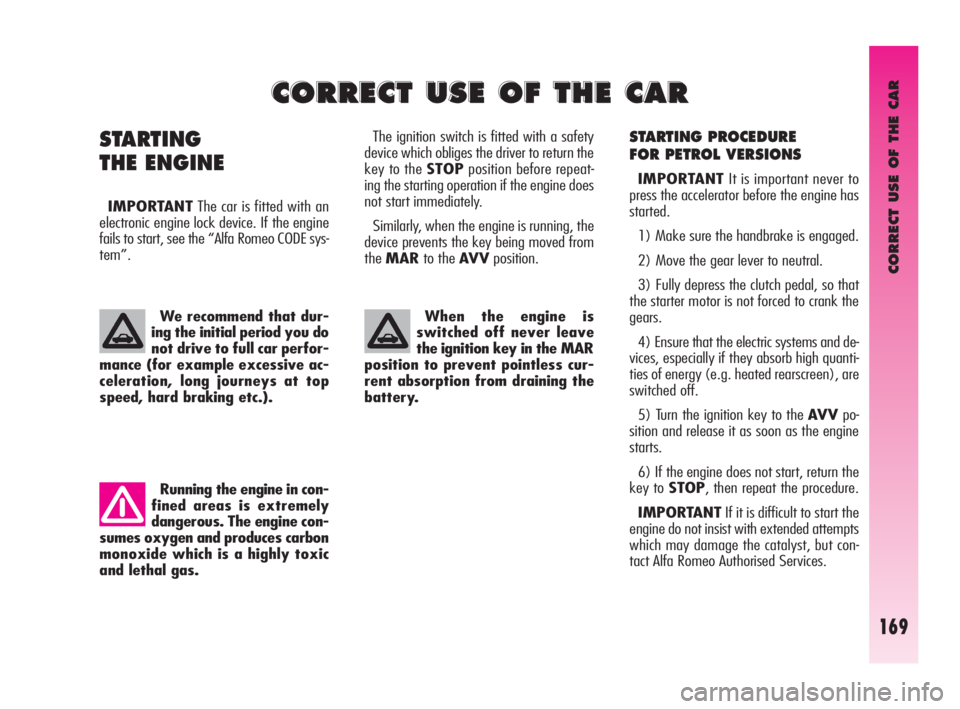
CORRECT USE OF THE CAR
169
STARTING PROCEDURE
FOR PETROL VERSIONS
IMPORTANTIt is important never to
press the accelerator before the engine has
started.
1) Make sure the handbrake is engaged.
2) Move the gear lever to neutral.
3) Fully depress the clutch pedal, so that
the starter motor is not forced to crank the
gears.
4) Ensure that the electric systems and de-
vices, especially if they absorb high quanti-
ties of energy (e.g. heated rearscreen), are
switched off.
5) Turn the ignition key to the AV Vpo-
sition and release it as soon as the engine
starts.
6) If the engine does not start, return the
key to STOP, then repeat the procedure.
IMPORTANTIf it is difficult to start the
engine do not insist with extended attempts
which may damage the catalyst, but con-
tact Alfa Romeo Authorised Services. The ignition switch is fitted with a safety
device which obliges the driver to return the
key to the STOPposition before repeat-
ing the starting operation if the engine does
not start immediately.
Similarly, when the engine is running, the
device prevents the key being moved from
theMARto the AV Vposition.
STARTING
THE ENGINE
IMPORTANTThe car is fitted with an
electronic engine lock device. If the engine
fails to start, see the “Alfa Romeo CODE sys-
tem”.
C C
O O
R R
R R
E E
C C
T T
U U
S S
E E
O O
F F
T T
H H
E E
C C
A A
R R
We recommend that dur-
ing the initial period you do
not drive to full car perfor-
mance (for example excessive ac-
celeration, long journeys at top
speed, hard braking etc.).
Running the engine in con-
fined areas is extremely
dangerous. The engine con-
sumes oxygen and produces carbon
monoxide which is a highly toxic
and lethal gas.
When the engine is
switched off never leave
the ignition key in the MAR
position to prevent pointless cur-
rent absorption from draining the
battery.
Page 172 of 271
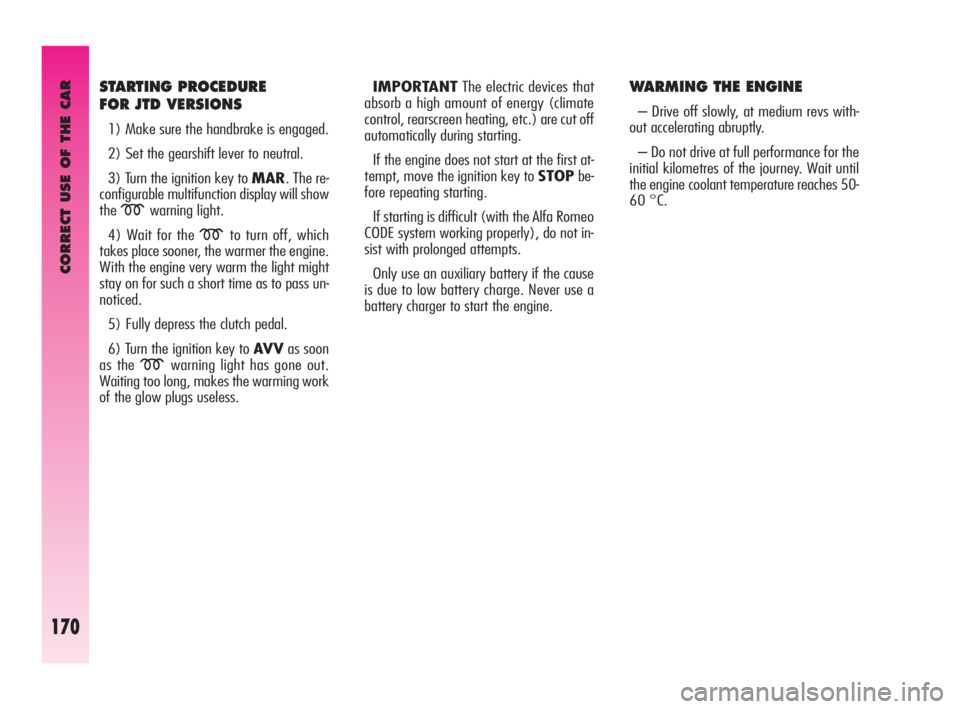
CORRECT USE OF THE CAR
170
STARTING PROCEDURE
FOR JTD VERSIONS
1) Make sure the handbrake is engaged.
2) Set the gearshift lever to neutral.
3) Turn the ignition key to MAR. The re-
configurable multifunction display will show
the
mwarning light.
4) Wait for the
mto turn off, which
takes place sooner, the warmer the engine.
With the engine very warm the light might
stay on for such a short time as to pass un-
noticed.
5) Fully depress the clutch pedal.
6) Turn the ignition key to AV Vas soon
as the
mwarning light has gone out.
Waiting too long, makes the warming work
of the glow plugs useless.IMPORTANTThe electric devices that
absorb a high amount of energy (climate
control, rearscreen heating, etc.) are cut off
automatically during starting.
If the engine does not start at the first at-
tempt, move the ignition key to STOPbe-
fore repeating starting.
If starting is difficult (with the Alfa Romeo
CODE system working properly), do not in-
sist with prolonged attempts.
Only use an auxiliary battery if the cause
is due to low battery charge. Never use a
battery charger to start the engine.
WARMING THE ENGINE
– Drive off slowly, at medium revs with-
out accelerating abruptly.
– Do not drive at full performance for the
initial kilometres of the journey. Wait until
the engine coolant temperature reaches 50-
60 °C.
Page 173 of 271
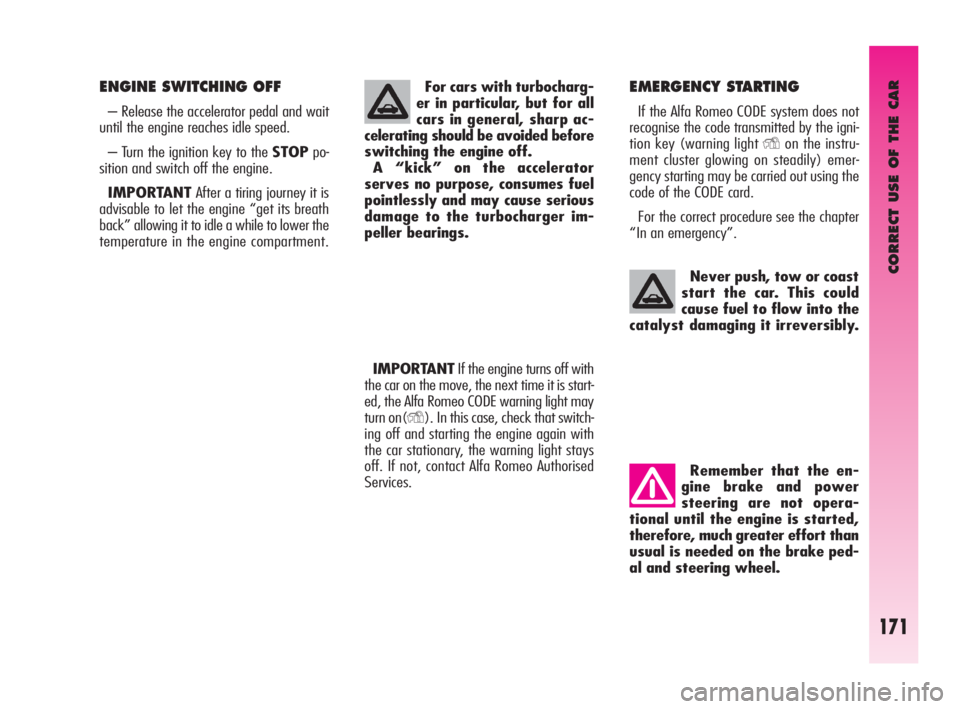
CORRECT USE OF THE CAR
171
Never push, tow or coast
start the car. This could
cause fuel to flow into the
catalyst damaging it irreversibly.
Remember that the en-
gine brake and power
steering are not opera-
tional until the engine is started,
therefore, much greater effort than
usual is needed on the brake ped-
al and steering wheel. For cars with turbocharg-
er in particular, but for all
cars in general, sharp ac-
celerating should be avoided before
switching the engine off.
A “kick” on the accelerator
serves no purpose, consumes fuel
pointlessly and may cause serious
damage to the turbocharger im-
peller bearings.
EMERGENCY STARTING
If the Alfa Romeo CODE system does not
recognise the code transmitted by the igni-
tion key (warning light
Yon the instru-
ment cluster glowing on steadily) emer-
gency starting may be carried out using the
code of the CODE card.
For the correct procedure see the chapter
“In an emergency”.
IMPORTANTIf the engine turns off with
the car on the move, the next time it is start-
ed, the Alfa Romeo CODE warning light may
turn on(
Y). In this case, check that switch-
ing off and starting the engine again with
the car stationary, the warning light stays
off. If not, contact Alfa Romeo Authorised
Services.
ENGINE SWITCHING OFF
– Release the accelerator pedal and wait
until the engine reaches idle speed.
– Turn the ignition key to the STOPpo-
sition and switch off the engine.
IMPORTANTAfter a tiring journey it is
advisable to let the engine “get its breath
back” allowing it to idle a while to lower the
temperature in the engine compartment.
Page 174 of 271
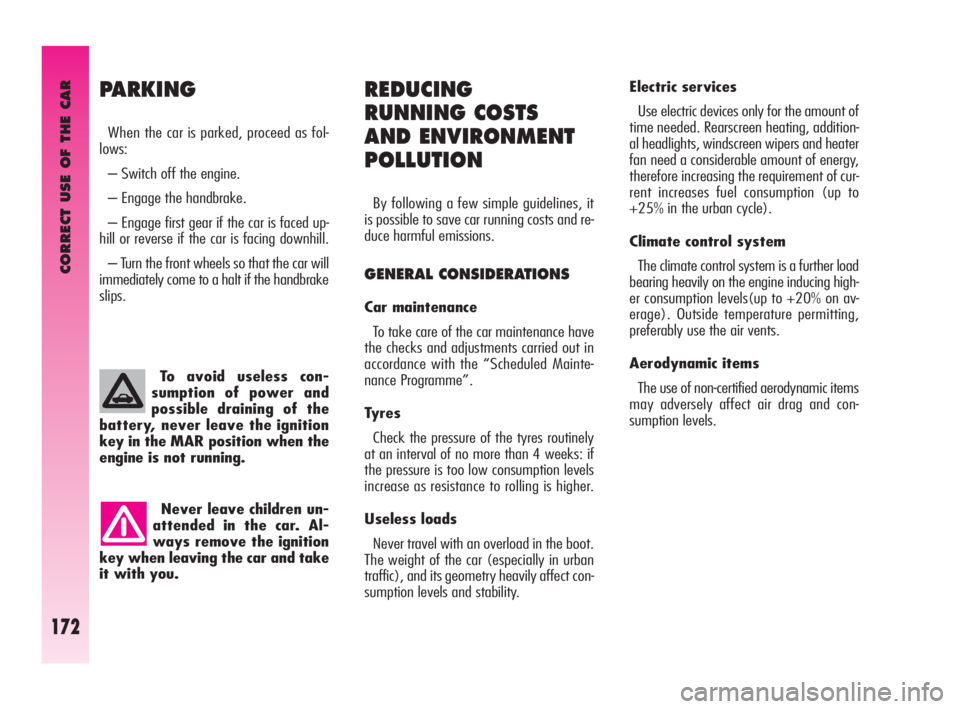
CORRECT USE OF THE CAR
172
Never leave children un-
attended in the car. Al-
ways remove the ignition
key when leaving the car and take
it with you.To avoid useless con-
sumption of power and
possible draining of the
battery, never leave the ignition
key in the MAR position when the
engine is not running.
PARKING
When the car is parked, proceed as fol-
lows:
– Switch off the engine.
– Engage the handbrake.
– Engage first gear if the car is faced up-
hill or reverse if the car is facing downhill.
– Turn the front wheels so that the car will
immediately come to a halt if the handbrake
slips.
REDUCING
RUNNING COSTS
AND ENVIRONMENT
POLLUTION
By following a few simple guidelines, it
is possible to save car running costs and re-
duce harmful emissions.
GENERAL CONSIDERATIONS
Car maintenance
To take care of the car maintenance have
the checks and adjustments carried out in
accordance with the “Scheduled Mainte-
nance Programme”.
Tyres
Check the pressure of the tyres routinely
at an interval of no more than 4 weeks: if
the pressure is too low consumption levels
increase as resistance to rolling is higher.
Useless loads
Never travel with an overload in the boot.
The weight of the car (especially in urban
traffic), and its geometry heavily affect con-
sumption levels and stability.Electric services
Use electric devices only for the amount of
time needed. Rearscreen heating, addition-
al headlights, windscreen wipers and heater
fan need a considerable amount of energy,
therefore increasing the requirement of cur-
rent increases fuel consumption (up to
+25% in the urban cycle).
Climate control system
The climate control system is a further load
bearing heavily on the engine inducing high-
er consumption levels(up to +20% on av-
erage). Outside temperature permitting,
preferably use the air vents.
Aerodynamic items
The use of non-certified aerodynamic items
may adversely affect air drag and con-
sumption levels.
Page 175 of 271

CORRECT USE OF THE CAR
173
CONDITIONS OF USE
Cold starting
Short journeys and frequent cold starts do
not allow the engine to reach optimum op-
erating temperature. This results in a sig-
nificant increase in consumption levels (from
+15 to +30% on the urban cycle) and emis-
sion of harmful substances.
Traffic situations and road
conditions
Rather high consumption levels are tied to
situations with heavy traffic, for example
in queues with frequent use of the lower
gears or in cities with many traffic lights. Al-
so winding mounting roads and rough road
surfaces adversely affect consumption.
Stopping in the traffic
During prolonged stops (e.g. level cross-
ings) it is advisable to switch the engine off.
DRIVING STYLE
Starting
Do not warm the engine with the car at a
standstill or at idle or high speed: under
these conditions the engine warms up much
more slowly, increasing electrical consump-
tion and emissions. It is therefore advisable
to move off immediately, slowly, avoiding
high speeds. This way the engine will warm
faster.
Pointless manoeuvres
Avoid accelerating when waiting at traffic
lights or before switching off the engine. This
and also double declutching is absolutely
pointless on modern cars and also increase
consumption and pollution.
Gearshifting
As soon as the conditions of the traffic and
road allow, use a higher gear.
Using a low gear to obtain brilliant per-
formance increases consumption.
In the same way improper use of a high
gear increases consumption, emissions and
engine wear.Top speed
Fuel consumption considerably increases
with speed. Maintain an even as possible
speed, avoiding superfluous braking and ac-
celerating, which cost in terms of both fuel
and emissions.
Acceleration
Accelerating heavily taking the engine to
a high speed has a considerably adverse ef-
fect on consumption and emission levels;
it is wise to accelerate gradually and not ex-
ceed the maximum torque.
Page 176 of 271
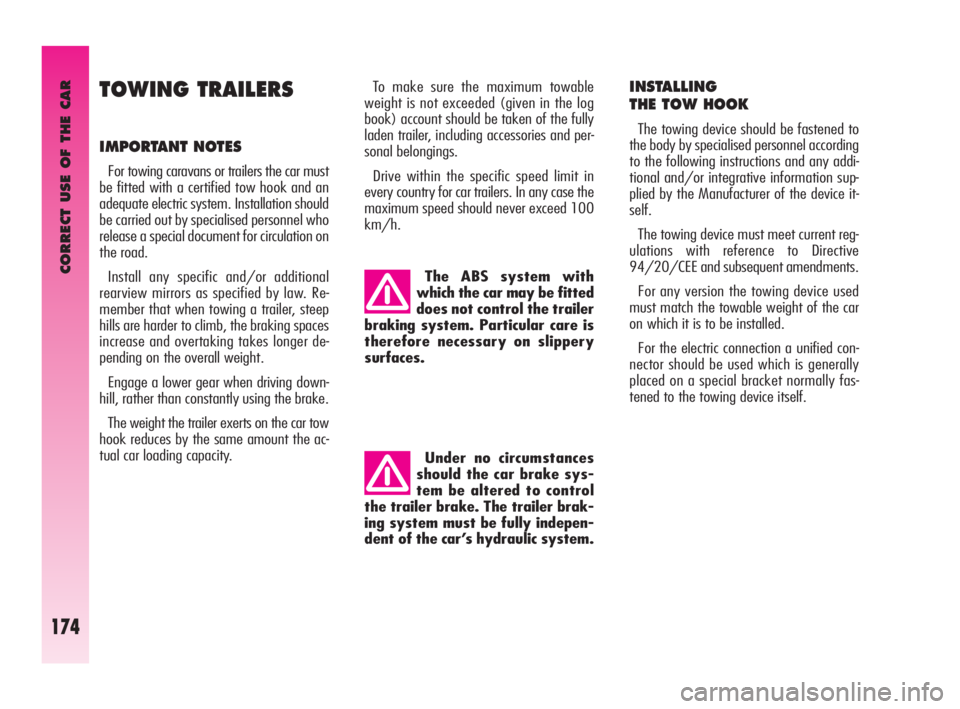
CORRECT USE OF THE CAR
174
TOWING TRAILERS
IMPORTANT NOTES
For towing caravans or trailers the car must
be fitted with a certified tow hook and an
adequate electric system. Installation should
be carried out by specialised personnel who
release a special document for circulation on
the road.
Install any specific and/or additional
rearview mirrors as specified by law. Re-
member that when towing a trailer, steep
hills are harder to climb, the braking spaces
increase and overtaking takes longer de-
pending on the overall weight.
Engage a lower gear when driving down-
hill, rather than constantly using the brake.
The weight the trailer exerts on the car tow
hook reduces by the same amount the ac-
tual car loading capacity.To make sure the maximum towable
weight is not exceeded (given in the log
book) account should be taken of the fully
laden trailer, including accessories and per-
sonal belongings.
Drive within the specific speed limit in
every country for car trailers. In any case the
maximum speed should never exceed 100
km/h.
INSTALLING
THE TOW HOOK
The towing device should be fastened to
the body by specialised personnel according
to the following instructions and any addi-
tional and/or integrative information sup-
plied by the Manufacturer of the device it-
self.
The towing device must meet current reg-
ulations with reference to Directive
94/20/CEE and subsequent amendments.
For any version the towing device used
must match the towable weight of the car
on which it is to be installed.
For the electric connection a unified con-
nector should be used which is generally
placed on a special bracket normally fas-
tened to the towing device itself. The ABS system with
which the car may be fitted
does not control the trailer
braking system. Particular care is
therefore necessary on slippery
surfaces.
Under no circumstances
should the car brake sys-
tem be altered to control
the trailer brake. The trailer brak-
ing system must be fully indepen-
dent of the car’s hydraulic system.
Page 177 of 271

CORRECT USE OF THE CAR
175
For the electrical connection a 7 or 13 pole
12VDC connection must be used (CU-
NA/UNI and ISO/DIN standards) following
any reference instructions given by the car
Manufacturer and/or towing device Manu-
facturer.
Any electric brake should be supplied directly
by the battery through a cable with a cross-
section of no less than 2.5 mm
2. In addition
to the electrical branches, the car electric sys-
tem can only be connected to the supply ca-
ble for an electric brake and to the cable for
an internal light, though not above 15W.
INSTALLATION LAYOUT
(fig. 1)
The tow hook structure must be fas-
tened in the points shown by the sym-
bol
Øusing 4 M8 screws and 7 M10
screws.
The inner plate (2) should have a
minimum thickness of 6 mm.
The inner plate (3) should have a
minimum thickness of 4 mm.
The inner plate (4) should have a
minimum thickness of 5 mm.
The fastening points (1) should be fit-
ted with 25 mm x 6 mm spacers.After fitting, the fasten-
ing screw holes shall be
sealed to prevent exhaust
gas inlet.
IMPORTANTIt is compulsory to fasten
a label (plainly visible) of suitable size and
material with the following wording:
MAX LOAD ON BALL 60 kg.
Page 178 of 271

CORRECT USE OF THE CAR
176fig. 1
A0A0680b
Existing holes
Existing holes
2 M10 screws3 M10 screws4 M8 screws
Standard tow ball2 M10 screwsSECTION A-A Existing holes
Fully laden vehicle
Page 179 of 271

CORRECT USE OF THE CAR
177
It is necessary therefore to limit their use
to the purposes for which they are certified.
IMPORTANTWhen winter tyres are
used with a maximum speed index below
the one that can be reached by the car (in-
creased by 5%), place a notice in the pas-
senger’s compartment, plainly in the driver’s
view, which states the maximum permissi-
ble speed of the winter tyres (as per EC Di-
rective).
Fit the same type of tyre on all four wheels
(brand and profile) to ensure higher driving
safety when braking and good handling.
Remember that it is inappropriate to
change the direction of rotation of tyres.WINTER TYRES
These tyres are specially designed for dri-
ving on snow and ice, to be fitted in re-
placement of those fitted on the car.
Use winter tyres of the same size as nor-
mal tyres provided on the car.
Alfa Romeo Authorised Services will be
pleased to advise you on the choice of the
tyre most suited to the use the Customer in-
tends to make of it.
For the type of tyre to be used, inflation
pressures and specifications of winter tyres,
follow the instructions given in the “Tech-
nical Specifications” chapter.
The winter features of these tyres are re-
duced considerably when the tread depth
is below 4 mm. In this case, they should be
replaced.
Due to the winter features, under normal
conditions of use or long motorway jour-
neys, the performance of these tyres is low-
er than that of normal tyres.
SNOW CHAINS
Use of snow chains should be in compli-
ance with local regulations.
For 1.8 T. SPARK, 2.0 JTS and 1.9
JTD versions, tyre 195/60 R15 can be
fitted with chains (use snow chains with re-
duced size with max protrusion beyond the
tyre profile of 12 mm). Tyres 205/60 R15
- 205/55 R16 - 205/55 ZR16 - 215/45
R17 - 215/45 ZR17 - 225/40 ZR18 can-
not be fitted with snow chains.
For 3.2
V6version, only use spider type
chains on tyres 215/45 R17” and
215/45 ZR 17”. Tyres 225/45 ZR17 -
225/40 ZR18 cannot be fitted with snow
chains.
Lineaccessori Alfa Romeo provides SPIKES
SPIDER COMPACT chains (model: 17003
compact) with 9 spikes, 16 mm adjustable
length and 17 inch wheel cap adapter.
Snow chains should only be applied to the
drive wheels (front).
Before purchasing or using snow chains,
you are recommended to contact Alfa
Romeo Authorised Services.
Check the tensions of the chain after the
first few metres have been driven.
Page 180 of 271
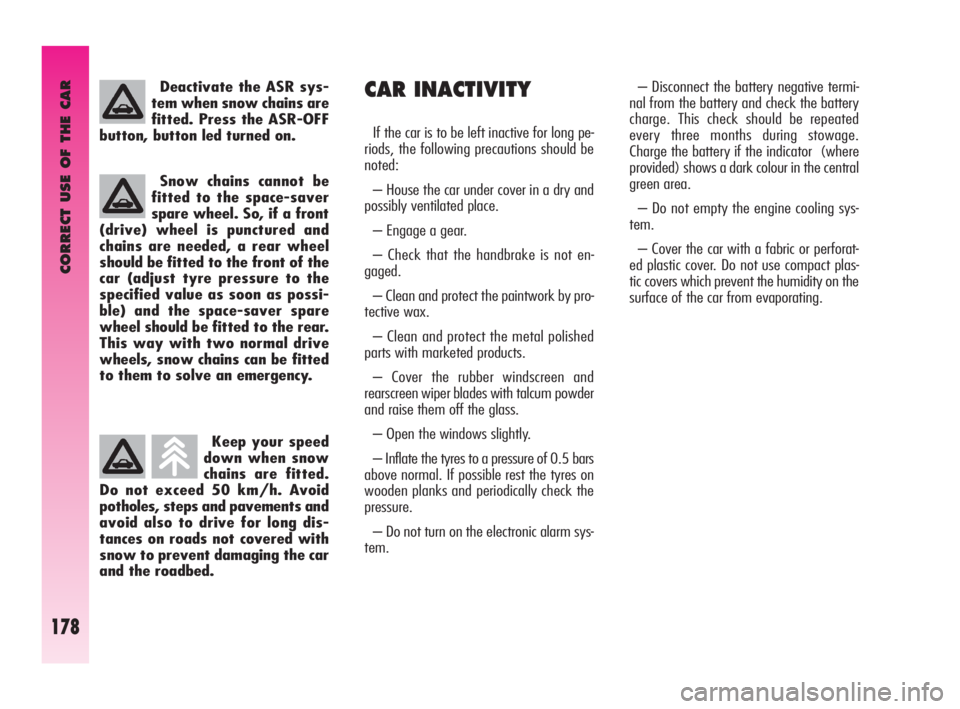
CORRECT USE OF THE CAR
178
Keep your speed
down when snow
chains are fitted.
Do not exceed 50 km/h. Avoid
potholes, steps and pavements and
avoid also to drive for long dis-
tances on roads not covered with
snow to prevent damaging the car
and the roadbed.
CAR INACTIVITY
If the car is to be left inactive for long pe-
riods, the following precautions should be
noted:
– House the car under cover in a dry and
possibly ventilated place.
– Engage a gear.
– Check that the handbrake is not en-
gaged.
– Clean and protect the paintwork by pro-
tective wax.
– Clean and protect the metal polished
parts with marketed products.
– Cover the rubber windscreen and
rearscreen wiper blades with talcum powder
and raise them off the glass.
– Open the windows slightly.
– Inflate the tyres to a pressure of 0.5 bars
above normal. If possible rest the tyres on
wooden planks and periodically check the
pressure.
– Do not turn on the electronic alarm sys-
tem.– Disconnect the battery negative termi-
nal from the battery and check the battery
charge. This check should be repeated
every three months during stowage.
Charge the battery if the indicator (where
provided) shows a dark colour in the central
green area.
– Do not empty the engine cooling sys-
tem.
– Cover the car with a fabric or perforat-
ed plastic cover. Do not use compact plas-
tic covers which prevent the humidity on the
surface of the car from evaporating. Snow chains cannot be
fitted to the space-saver
spare wheel. So, if a front
(drive) wheel is punctured and
chains are needed, a rear wheel
should be fitted to the front of the
car (adjust tyre pressure to the
specified value as soon as possi-
ble) and the space-saver spare
wheel should be fitted to the rear.
This way with two normal drive
wheels, snow chains can be fitted
to them to solve an emergency.
Deactivate the ASR sys-
tem when snow chains are
fitted. Press the ASR-OFF
button, button led turned on.